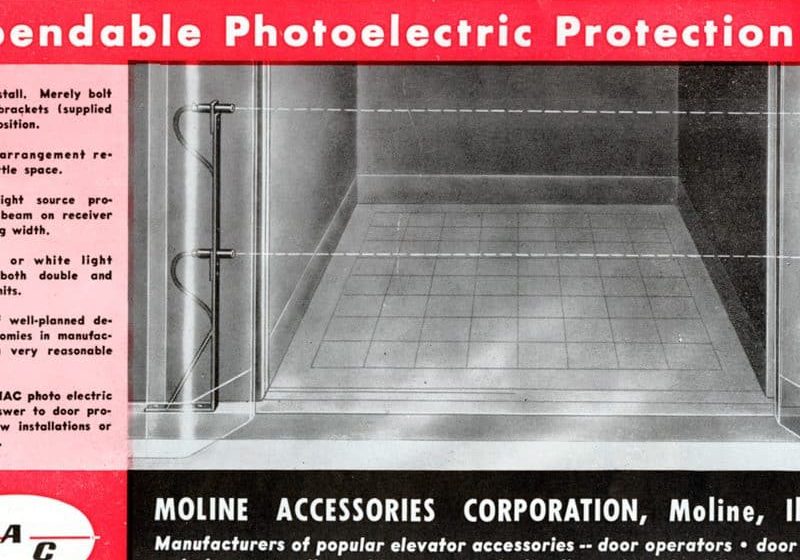Revisiting an Icon
May 1, 2014
EW tours “Victorian rocket ships” in the Hyatt Regency Atlanta as historic Polaris Lounge reopens.
Even if one doesn’t possess the psychedelic mindset of the late rock star Jim Morrison, he or she understands what Morrison meant when he described the elevators in the Hyatt Regency Atlanta as “. . . kind of [like] Victorian rocket ships.” Your reporter recently visited the elevators — covered by ELEVATOR WORLD upon their debut in 1967 — to learn more about them, especially in light of the April reopening of the hotel’s historic revolving lounge, Polaris, which overlooks downtown Atlanta.
One of a cluster of downtown Atlanta buildings forming Peachtree Center that architect John C. Portman, Jr. designed in his hometown, the Hyatt reaches 340 ft. from sub basement to rooftop. It is notable for its soaring atrium, which houses five glass-enclosed elevator cabs traveling up and down a central shaft. The units are a whimsical yet striking feature of the hotel and its atrium, a design combination that became Portman’s hotel signature and would be replicated not only in Atlanta, but throughout the U.S. and world.
Including additions built in the early 1970s and early 1980s, the Hyatt houses 1,260 rooms. Its atrium elevators have:
- A capacity of 3000 lb. each
- Three cars serving 24 floors
- One car serving 27 floors
- One car serving 25 floors
- A speed of 700 fpm
Such vertical-transportation systems are an integral part of all Portman buildings and were designed by Portman specifically for them. Portman states:
“The observation elevators in the Hyatt Regency Atlanta came out of the desire to offer the guest a sensory experience. Elevators in an atrium can be more than a mode of transportation. Pulled from their shafts and freed from enclosing walls, they become exhilarating experiences for riders and kinetic sculpture for observers.”
As Atlanta grew up around the Hyatt and Polaris, buildings began to constrict the view, although there is still plenty to see from the Polaris windows. “There’s the Coca-Cola building there, and over there is the Georgia Dome,” Project Manager Richard Krilla observed. One is also treated to a brief yet impressive view of the cityscape as the elevator passes by the rooftop on its way to and from Polaris.
Otis manufactured the cabs in the 1960s at a record-setting price of US$35,000 each. Today, they are lovingly cared for by resident Otis elevator technician Eddie Lewis, who refers to them as his babies. Thanks to getting regular maintenance, they remain as state of the art today as they were when they began running. They are smooth and fast. Lewis starts his workday with an engineering meeting, then spends up to several hours riding the elevators and checking their equipment, typically in the wee hours before hotel guests begin to stir. Often, he cleans and lubricates them. “You ride them a lot,” Lewis said. “You have to use your slow periods to go in, check your equipment and make any repairs that need to be made.”
When your reporter visited, the Polaris was filled with the sound of hammers and the smell of sawdust as workers got the space ready for bartenders to serve its famous peach daiquiris once again. The Polaris actually sits below the spaceship-like blue dome that is the Hyatt’s trademark. The dome houses elevator equipment, including two 219 HT gearless machines and an archaic-looking Otis flyball governor. Lewis explains the governor’s purpose and how it works:
“This original device monitors the speed of the elevator. As the elevator begins to move, the weighted balls sling outward with centrifugal force. A series of linkages are calibrated to trip a safety switch if the car runs faster than normal speed (700 fpm). This will stop the car electrically. This switch has to be manually reset to alert our techs of an overspeed occurrence. A second, and more important, function is calibrated at a slightly higher speed. This step triggers the ‘safety jaws’ and sets the ‘safeties’ under the car. The purpose is to stop an elevator from freefalling. The equipment is tested periodically to ensure proper performance. This portion of the elevator is all original Otis engineering.”
The dome casts an otherworldly glow over everything underneath it, similar to a blacklight. Lewis said that, as a result, mechanics working on the system have learned to go by numbers, rather than colors.
After the renovation, one of the atrium elevators again travels up to the Polaris, as well as to an Americans with Disabilities Act-compliant bathroom recently installed on an upper floor. In addition to the elevators, equipment includes six escalators and an original 1960 Peelle dumbwaiter with Otis controls that was rewired and given new door switches and safeties to bring it up to modern code for the reopening. The dumbwaiter has a capacity of 500 lb., a speed of 50 fpm and makes three stops.
In addition to the elevators, equipment includes six escalators and an original 1960 Peelle dumbwaiter with Otis controls that was rewired and given new door switches and safeties to bring it up to modern code for the reopening.
In 1990, the elevators underwent their last major overhaul, which involved replacing moving parts such as generators and selectors with microprocessors, Lewis said. Krilla said that since then, maintenance has been primarily cosmetic, such as replacing glass and light fixtures, or adding computer monitors to cab interiors. Overall, however, the cabs are much the same as when Morrison rode them in 1970. Black-and-white photographs in the elevator lobby attest to this fact.
The ground floor of the atrium once housed a lounge — as well as trees, plants and parrots in giant cages — to which guests would sometimes feed alcohol-infused fruit from their drinks. Portman’s idea was for the space to evoke Copenhagen, Denmark’s Tivoli Gardens. The lounge, birds and trees have given way to a sleeker, cleaner look with a scattering of stores and concierge desk, but the soul of Portman’s architectural vision remains. Looking into the atrium from either balconies high above or from the ground, several elements provide structure. These are, most notably, the elevator shaft with the lighted cars traveling up and down, a gold, treelike sculpture that is an original feature of the building and — when viewed from above — a circular well housing the escalator system. When one is standing at ground level, a corresponding roof window resembles a moon shining down on some alien planet. Traversing a Portman building is, in a word, fun. Although he was sometimes criticized for creating insular designs that turned their back on urban surroundings, Portman won praise, as well, including from sometime-critics Paul Goldberger and Herbert Muschamp, who likened Portman’s designs to “architecture at happy hour.” Peach daiquiris, anyone?
Portman Buildings in the Movies
Because of their striking designs, Portman buildings have served as settings in numerous movies, including the Hyatt Radius Tower, which was a stunt double for the similar Westin Peachtree Plaza in the 1981 Burt Reynolds movie Sharky’s Machine and, more recently, the atrium of the Atlanta Marriott Marquis serving as a backdrop for scenes in The Hunger Games: Catching Fire.
Redefining the Modern Hotel — Elevators and Atriums
Your reporter asked architect John C. Portman, Jr. to explain what elevators and atriums mean to him and his career, and to hotel design. Here is how he responded:
“Without the atrium, there would be no reason for observation elevators. During the early 1960s, we took on the challenge of building the first major hotel in Atlanta in 40 years. The site was in the center of the city on a block surrounded by other buildings. The streets were jammed with vehicular traffic. Sidewalks were very active.
“In this context, we thought first of the city as a whole, in terms of interior and exterior space. What should a hotel offer in this circumstance? How could architecture make urban areas more responsive to human needs?
“We analyzed existing urban hotels and found that most central city hotels were built on cramped blocks. They had a low-ceilinged lobby with a registration desk in the back, a few lobby chairs, maybe a newsstand or a dark bar off in the corner. Guests took small, enclosed elevators to access their rooms along dimly lit narrow corridors with nondescript room doors — not a very welcome experience for the weary traveler.
“We wanted to do something that was the antithesis to that tight, confining space. We figuratively “exploded” the 22-story Hyatt Regency Atlanta to create a high-rise atrium, redefining interior space on a grand scale. Our goal was to open the lobby of the hotel with a new form of grand space in which people could enjoy a variety of activities.
“People enjoy watching people. Some relish being observed. Others prefer to sit anonymously in the crowd and watch everyone else go by. The space within the hotel atrium can become a living room of life. People move along the upper floors’ guestroom corridors. Elevators travel up and down. Diners enjoy meals in interior ‘sidewalk’ cafés. Children play by the fountain. In the tradition of European city centers, the atrium can be an animated, modern-day public piazza.
“The Hyatt Regency Atlanta was the first modern-day atrium. It launched my career as a hotel architect, and it launched the Hyatt as a major hotel brand. With time and technology, new forms have evolved in atrium design, yet basic principles endure. Because people are responsive to it, atrium space has taken root in office buildings, retail malls, educational and governmental buildings, as well as hotels and resorts.”
“We figuratively ‘exploded’ the 22-story Hyatt Regency Atlanta to create a high-rise atrium, redefining interior space on a grand scale.” — John C. Portman, Jr.
Get more of Elevator World. Sign up for our free e-newsletter.









